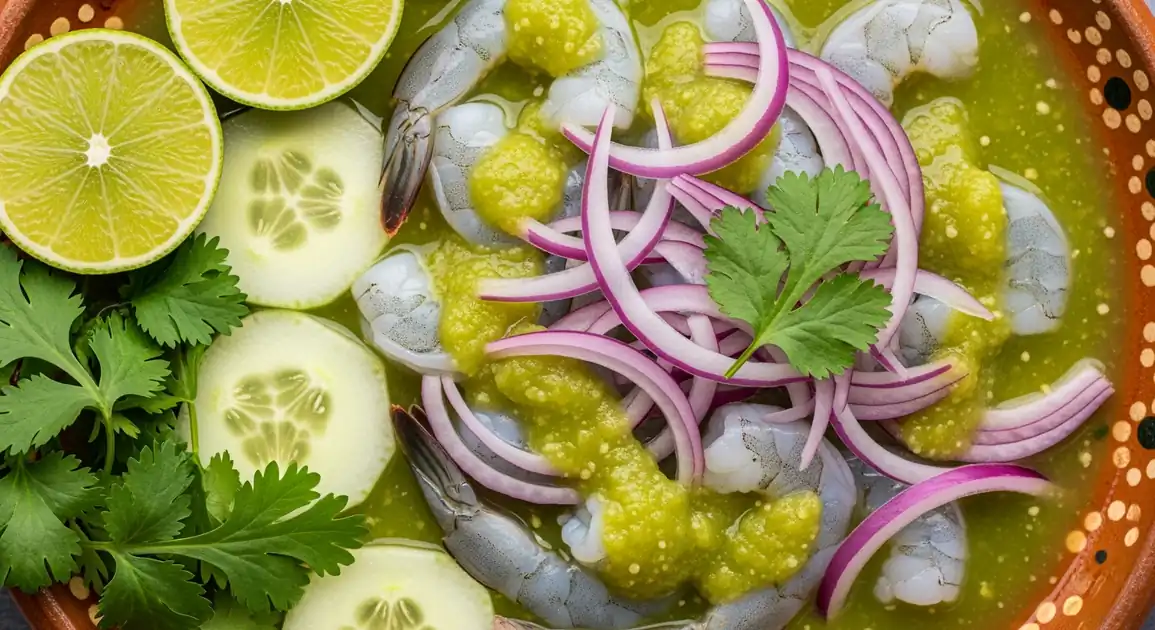Aguachile
Aguachile

Description
Aguachile is beloved throughout Mexico, though styles and preparations vary by region. While originating in Sinaloa, it's now popular nationwide, with coastal areas typically offering the freshest versions. Mexico's diverse chile peppers allow for numerous regional adaptations of the dish's signature spicy sauce.
Dietary Information
Serving information
Serving style
Typically served in a wide, shallow dish to spread the seafood in a thin layer, allowing even marination. Almost always accompanied by tostadas or saltine crackers, lime wedges, and often avocado slices.
Quick facts
Most marisquerías operate from 11 AM - 6 PM, with peak freshness in the morning to early afternoon.
Safety Tips
What to Look For
-
Translucent, plump shrimp or fish
Properly fresh raw seafood should appear somewhat translucent, firm, and moist. Avoid seafood that looks opaque, mushy, or has discolored edges.
-
Refrigerated display case for seafood
Proper refrigeration is essential for raw seafood safety. Look for establishments with visible refrigeration for their seafood.
-
High customer turnover
Busy restaurants cycle through ingredients faster, meaning seafood is less likely to sit around. This is especially important for raw dishes.
-
Clean preparation areas
Visible kitchen cleanliness indicates good food handling practices and reduces cross-contamination risk.
-
Made-to-order preparation
Aguachile should ideally be prepared to order, not sitting pre-made, to ensure optimal freshness and texture.
What to avoid
-
Strong fishy odor
Fresh seafood should smell clean and oceanic, not fishy. A strong fishy smell indicates decomposition has begun.
-
Grey or discolored shrimp
Shrimp should be a translucent greyish-blue when raw (or pinkish if briefly lime-cured). Avoid yellow, black spots, or unnaturally white appearance.
-
Pre-prepared aguachile sitting out
Since aguachile continues to 'cook' in lime juice, pre-made batches can become tough and potentially unsafe if left too long.
-
Cross-contamination signs
Watch for staff handling raw seafood and other foods without changing gloves or washing hands.
-
Warm serving temperature
Aguachile should be served chilled. Room temperature or warm raw seafood dishes present significant safety risks.
Price information
Price range
Budget tips
- Local marisquerías away from tourist areas generally offer better prices (150-200 MXN).
- Lunch specials ('comida corrida') sometimes include aguachile at a discount.
- Larger portions meant for sharing can offer better value per person.
- Coastal towns generally offer more affordable aguachile than inland areas.
Value indicators
- Generous portion of seafood (not mostly cucumber and onion).
- Seafood appears fresh and properly prepared.
- Complimentary tostadas or crackers included.
- Balanced flavor with noticeable chile heat and acidity.
Where to Find This Dish
Coastal Areas
Beach towns and coastal cities have the highest concentration of quality aguachile vendors.
Local fish markets, Beachfront restaurants
Morning, Early Afternoon
Market Areas
Seafood sections of major markets often feature vendors specializing in raw seafood preparations.
Seafood halls in municipal markets
Morning, Midday
Restaurant Districts
Areas known for seafood restaurants and marisquerías.
Restaurant rows in major cities
Lunch, Early Afternoon
Vendor Tips
- Ask 'A qué hora llegó el marisco?' (When did the seafood arrive?) to gauge freshness.
- Look for places displaying where their seafood comes from.
- Request 'poco picante' (less spicy) if you're sensitive to heat.
How to Order
Regional Variations
-
Aguachile Verde
(Aguachile Verde)
The traditional and most common version made with green chiles (typically serranos or jalapeños), lime juice, and cilantro, giving it a bright green color.
-
Aguachile Negro
(Aguachile Negro)
A darker variation that incorporates soy sauce or sometimes squid ink, typically made with habanero chiles for extra heat.
-
Aguachile Rojo
(Aguachile Rojo)
Made with red chiles such as chiltepin or red jalapeños, sometimes incorporating a touch of fruit like mango or passion fruit.
-
Aguachile de Pescado
(Aguachile de Pescado)
Uses thin slices of white fish (typically sea bass or snapper) instead of the traditional shrimp.
-
Aguachile de Mariscos Mixtos
(Aguachile de Mariscos Mixtos)
A mixed seafood version featuring combinations of shrimp, scallops, octopus, and fish.
-
Aguachile Vegetariano
(Aguachile Vegetariano)
Vegetarian adaptation using mushrooms (typically oyster mushrooms), hearts of palm, jicama, or young coconut meat.
Cultural context
History
Aguachile originated in the coastal state of Sinaloa in northwestern Mexico, traditionally prepared by mountain-dwelling ranchers using dried chiltepín chiles crushed with water to create a spicy liquid for preserving and flavoring dried meat. As the dish evolved and reached coastal areas, fresh seafood (primarily shrimp) replaced meat, and fresh lime juice was incorporated to 'cook' the seafood. Now popular throughout Mexico and internationally, the dish represents the perfect marriage of inland chile culture with coastal seafood traditions.
Local significance
Represents Mexico's mastery of balancing bold flavors and its rich coastal culinary traditions. Often associated with celebration, social gatherings, and weekend activities.
Eating customs
- Eaten with tostadas or saltine crackers rather than alone.
- Mixed immediately before eating.
- Often combined with other seafood appetizers in a 'torre de mariscos' (seafood tower).